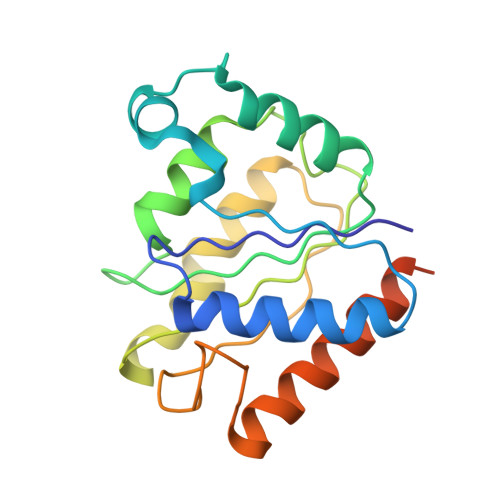Crystal Structure of Escherichia coli SsuE: Defining a General Catalytic Cycle for FMN Reductases of the Flavodoxin-like Superfamily.
Driggers, C.M., Dayal, P.V., Ellis, H.R., Karplus, P.A.(2014) Biochemistry 53: 3509-3519
- PubMed: 24816272
- DOI: https://doi.org/10.1021/bi500314f
- Primary Citation of Related Structures:
4PTY, 4PTZ, 4PU0 - PubMed Abstract:
The Escherichia coli sulfur starvation utilization (ssu) operon includes a two-component monooxygenase system consisting of a nicotinamide adenine dinucleotide phosphate (NADPH)-dependent flavin mononucleotide (FMN) reductase, SsuE, and a monooxygenase, SsuD. SsuE is part of the flavodoxin-like superfamily, and we report here the crystal structures of its apo, FMN-bound, and FMNH2-bound forms at ∼2 Å resolution. In the crystals, SsuE forms a tetramer that is a dimer of dimers similar to those seen for homologous FMN reductases, quinone reductases, and the WrbA family of enzymes. A π-helix present at the tetramer building interface is unique to the reductases from two-component monooxygenase systems. Analytical ultracentrifugation studies of SsuE confirm a dimer-tetramer equilibrium exists in solution, with FMN binding favoring the dimer. As the active site includes residues from both subunits, at least a dimeric association is required for the function of SsuE. The structures show that one FMN binds tightly in a deeply held site, which makes available a second binding site, in which either a second FMN or the nicotinamide of NADPH can bind. The FMNH2-bound structure shows subtle changes consistent with its binding being weaker than that of FMN. Combining this information with published kinetic studies, we propose a general catalytic cycle for two-component reductases of the flavodoxin-like superfamily, by which the enzyme can potentially provide FMNH2 to its partner monooxygenase by different routes depending on the FMN concentration and the presence of a partner monooxygenase.
- Department of Biochemistry and Biophysics, Oregon State University , 2011 Agricultural and Life Sciences Building, Corvallis, Oregon 97331, United States.
Organizational Affiliation:


















